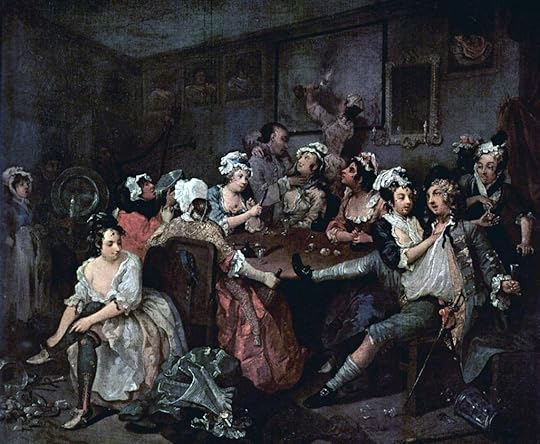The protagonist interviews his creator, part 2

rom “A Rake’s Progress” by William Hogarth, circa 1732-33.
Fictional comic book writer Ray Sirico’s interview with his own creator, FANDEMONIUM author Rick Schindler, resumed after a lengthy pause for liquid refreshment.
Ray S.: That’s better. So, we’ve established that I am an ideal subject for a novel. But why set it in 1993?
Rick S.: Well, 1992 was the death of Superman—
Ray S.: Who?
Rick S.: Superman. Strange visitor from another planet with awesome powers and questionable fashion sense. The prototypical superhero.
Ray S.: Not where I come from. There’s nothing about him in FANDEMONIUM. I oughtta know, I live in there.
Rick S.: Oh, right. That’s because I thought a novel about comics might be more fun if I populated its background with imaginary comics characters instead of the ones everybody already knows.
Ray S.: And I commend your decision. But why 1993?
Rick S.: Well, Superman—
Ray S.: Fuck Superman, whoever he is. The reason 1993 is important is because that’s the year the World Wide Web was born.
Rick S.: You’ve never heard of Superman, yet you know about the Internet?
Ray S.: You established in the novel that I do; it comes up several times. And 1993 was the year CERN published the first graphical website.
Rick S.: What’s that got to do with a novel about comic books?
Ray S.: Note the term graphical.
Rick S.: You’re suggesting the Web is like an enormous comic book?

Thomas Nast cartoon from Harper’s Weekly, 1872.
Ray S.: More like an enormous rack filled with them. Consider the Web’s profusion of gaudy images, its lurid banners and blurbs, its dearth of nuance, its abundance of funny animals and crappy ads for dubious products, its reduction of narrative to a binary battle between good guys and bad guys. Hell, look at Twitter, where communication is limited to bursts of 140 characters— pretty much the same number you can fit into a comic book caption or word balloon.
Rick S.: You know about Twitter?!
Ray S.: I have my own feed.
Rick S.: You’re not even real, for Christ’s sake.
Ray S.: You don’t need to be real to tweet; you hardly even need to be literate. How old were you when you learned to read?
Rick S.: What? Uh, 4, maybe.
Ray S.: In school?
Rick S.: No. My mom says I taught myself to read from comic books.
Ray S.: As did I. As did any number of others of our generation. Comics are the natural cradle of literacy.
Rick S.: Oh please. The medium is barely a century old. Even if you count newspaper comics and editorial cartoons—
Ray S.: What about Winsor McCay? What about Thomas Nast? What about Beardsley? What about Hogarth?
Rick S.: Well, I suppose those are sorts of graphical storytelling—
Ray S.: As are Japanese woodcuts, stained glass church windows, medieval tapestries, illuminated manuscripts, Egyptian hieroglyphics, prehistoric cave paintings—
Rick S.: You’re drunk.
Ray S.: Granted, but that doesn’t mean I don’t know what I’m talking about. The Book of Kells! The Elgin Marbles! The Temple of Karnak! The Cave of Altamira!

Frieze from the Karnak temple in Egypt.
Rick S.: You’ve lost your Elgin marbles. You’re ranting.
Ray S.: Of course I am. It’s what I do. The point is, comics, cartoons, graphical storytelling, call it what you will, transcend literacy and language. They were there before literacy existed, and they’ll be there after it’s dead and buried in the vast necropolis of the Internet. In the future there will be no words: only images and emoticons, binary clicks and grunts ricocheting endlessly across the cyberverse. Here’s to postliteracy!
Rick S.: Dick and Jane, we hardly knew ye.
Rick Schindler's Blog



